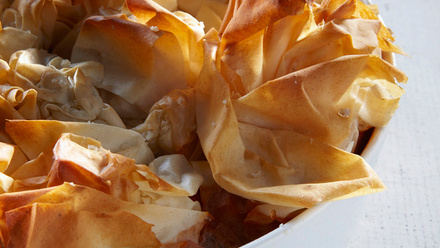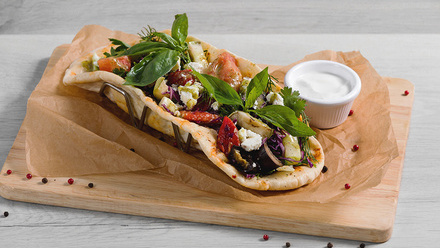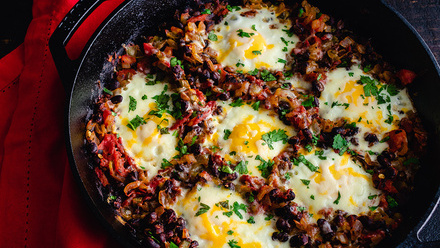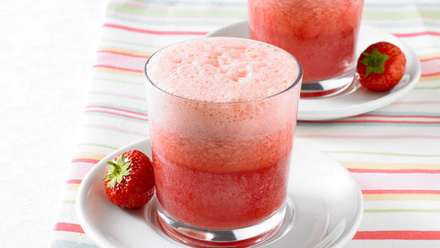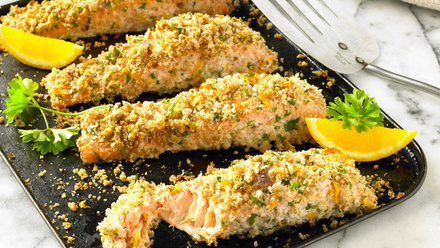It is much easier than you might think to make stock from a chicken carcass. It takes time, but you don’t need to be standing over the pot as the stock cooks itself. You can make this on the hob or put it in the oven on a low heat for up to eight hours.
Ingredients
Chicken carcass (from a roasted chicken)
1 medium carrot
1 medium onion
2 celery sticks (optional)
1 bulb garlic
10g (about a handful) fresh herbs, such as rosemary, thyme, bay leaf, sage OR 2 x 5ml spoons dried mixed herbs
Whole black peppercorns (optional)
4 litres water
Equipment
Scissors
Very large saucepan (ovenproof if cooking in the oven)
Colander
Chopping board
Sharp knife
Measuring spoons (optional)
Measuring jug
Oven gloves
Sieve
Smaller saucepan
Pan stand
Instructions
- Make sure you have picked off any excess meat from the chicken and saved it for another dish.
Pull away the leg and wing bones and then, using scissors, chop the carcass into pieces small enough to fit easily into your saucepan. - Wash the vegetables but don’t peel them, chop into chunks and place in the pan. Peel the onion and slice off the very tip of the root (to clean it), then cut it in half first then into large pieces, leaving the root intact. Put the chopped onion into the pan. Chop the bulb of garlic in half and add to the pan. Add in any herbs you have growing or left over in the fridge or the dried herbs and whole black peppercorns to taste (if using).
- Cover the chicken pieces with water, approximately 3–4 litres, though the exact amount will depend on the size of your pan. The less water there is, the more likely it is that the pan will boil dry. Cover with a lid or kitchen foil and wrap tightly.
- Place on the hob and slowly bring to the boil, then turn down the heat. If you are cooking it on the hob, cook at a slow simmer for a further 3 hours, checking at intervals to make sure there is enough water to cover the bones. If you want to leave it, place the whole pan in the oven at 140°C/120°C fan or gas mark 1 and leave for up to 5 hours, or 125°C/105°C fan or gas mark ½ if you want to leave it cooking for up to 8 hours.
- When it is ready, strain off the stock from the bones into another saucepan and leave to drain for 5 minutes.
- Boil the strained stock at a rolling boil (lots of bubbling) until it has reduced by half. You should be left with about 1.5 litres of stock. Cool, then store in airtight containers in the fridge or freezer until required.
Skills used include:
Chopping, boiling/simmering and cooling.
Top Tips
- Include the skin in the stock as it contains lots of flavour. Any fat that appears in the stock can be skimmed off the top when it is cold.
- If your sieve has large holes, line it with a new or clean J-cloth to catch any smaller bits of bone.
Something to try next time
- To make a rich brown stock (demi-glace) keep reducing the stock until it is very dark in colour and sets to a firm jelly. Chefs use this for posh sauces.
- Ask your butcher for chicken carcasses, they cost almost nothing. You can either roast the carcasses for a brown stock, or make the stock from unroasted carcasses, which will give a paler stock more suitable for delicate recipes.
- Try adding vegetables you have leftover in the fridge. Tomatoes are great, as are any root vegetables (except potatoes, which will just make the stock starchy and cloudy).
Prepare now, eat later
- Freeze in ice-cube trays or rubber/silicon cupcake cases, then pop out when frozen into a freezer
bag, ready to use whenever needed. Freeze for up to 3 months. - If you have a large enough pan, you can double or triple this recipe and make lots of stock for lovely
soups, risottos and sauces. - Add the frozen stock cubes to casseroles and soups or your Sunday roast gravy.
- Make sure any frozen stock is fully defrosted and boiling hot before serving.


